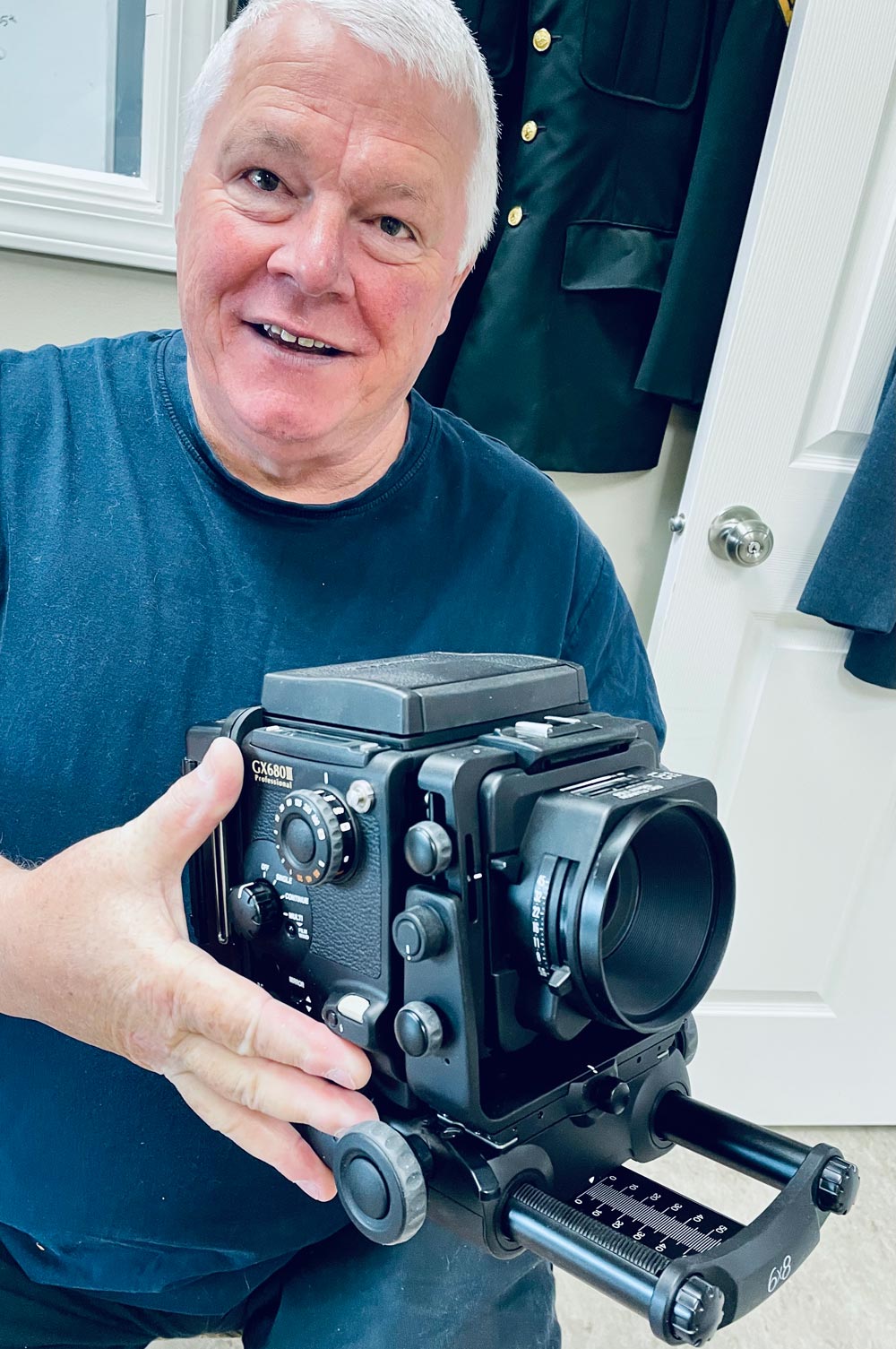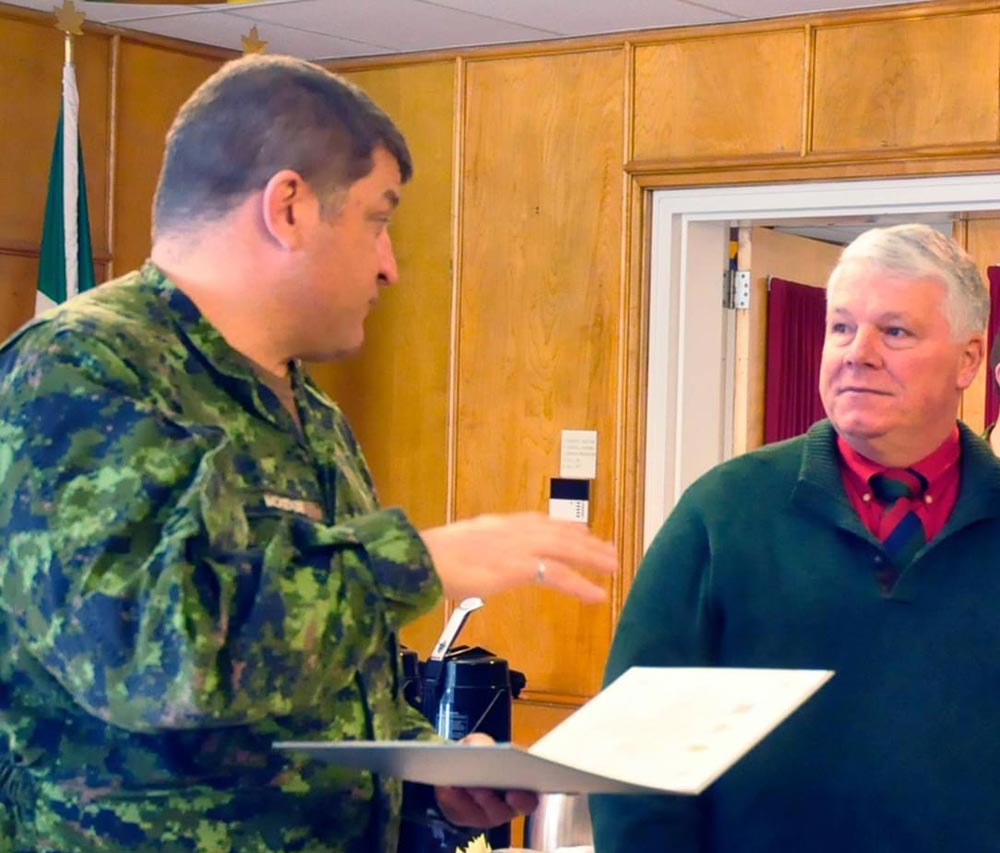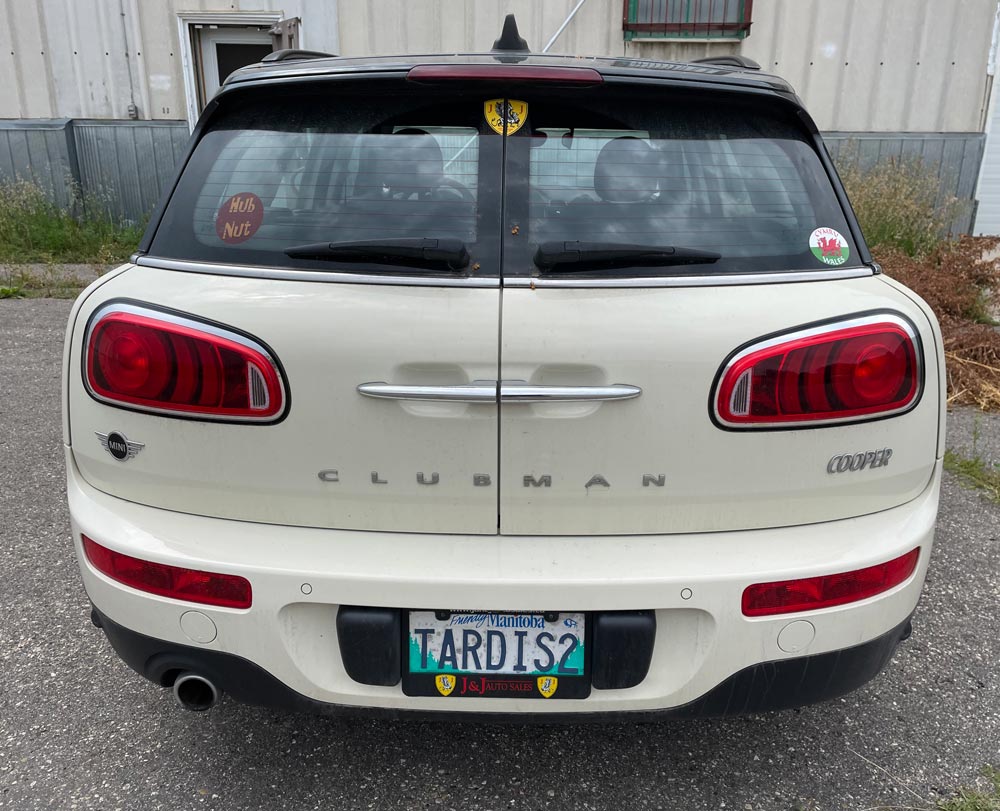

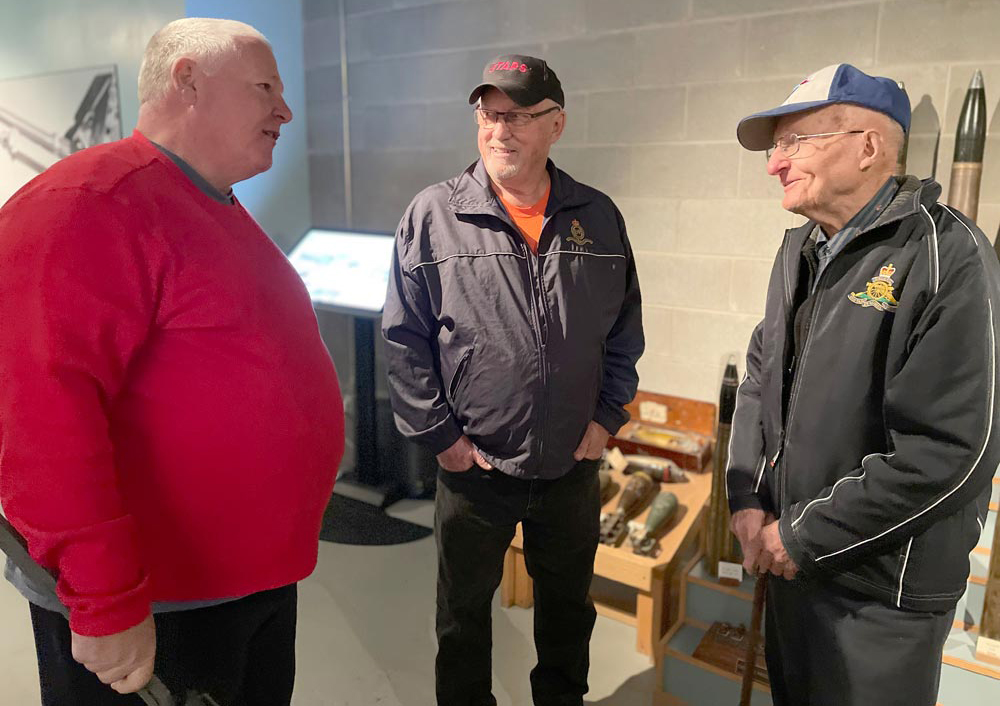

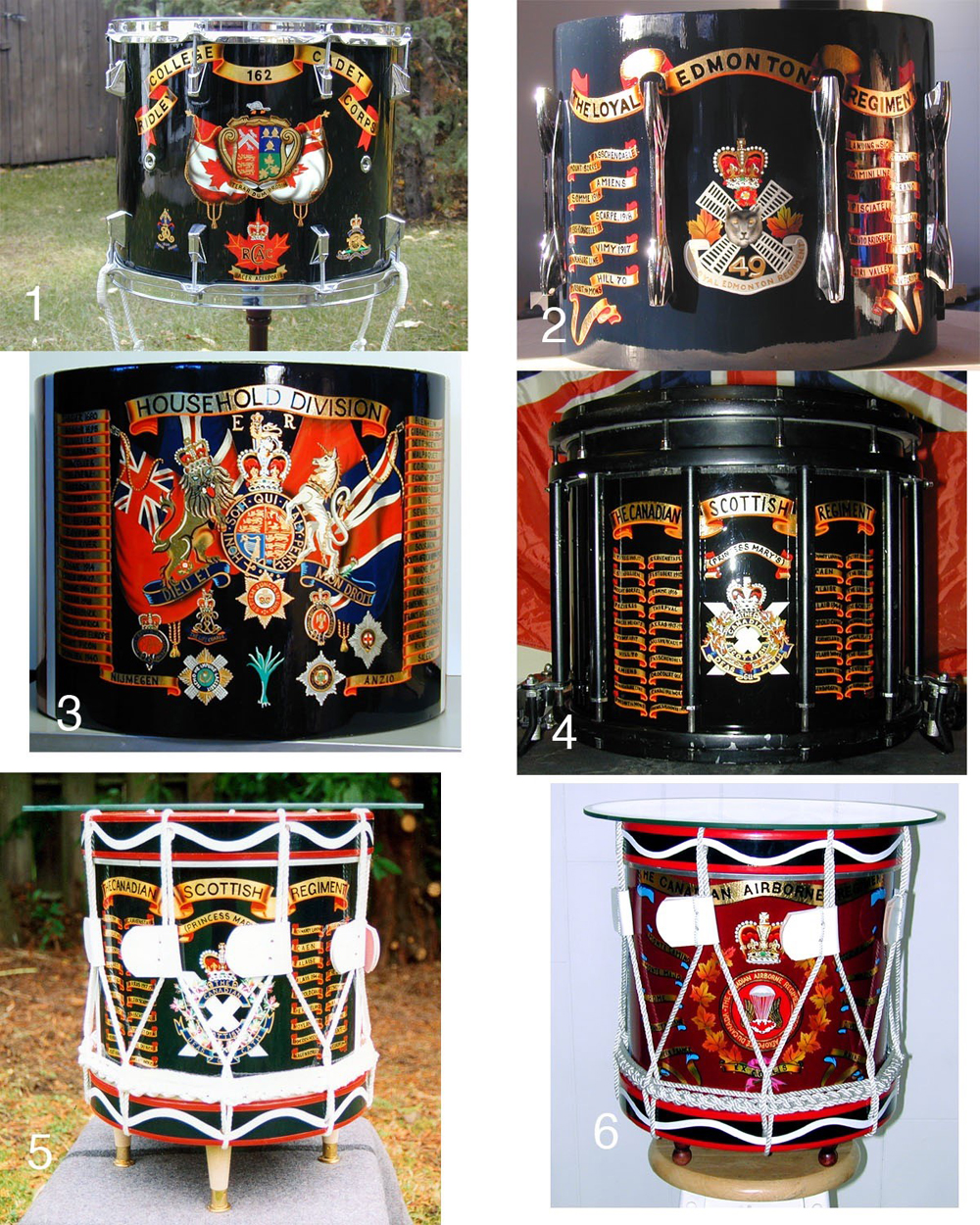
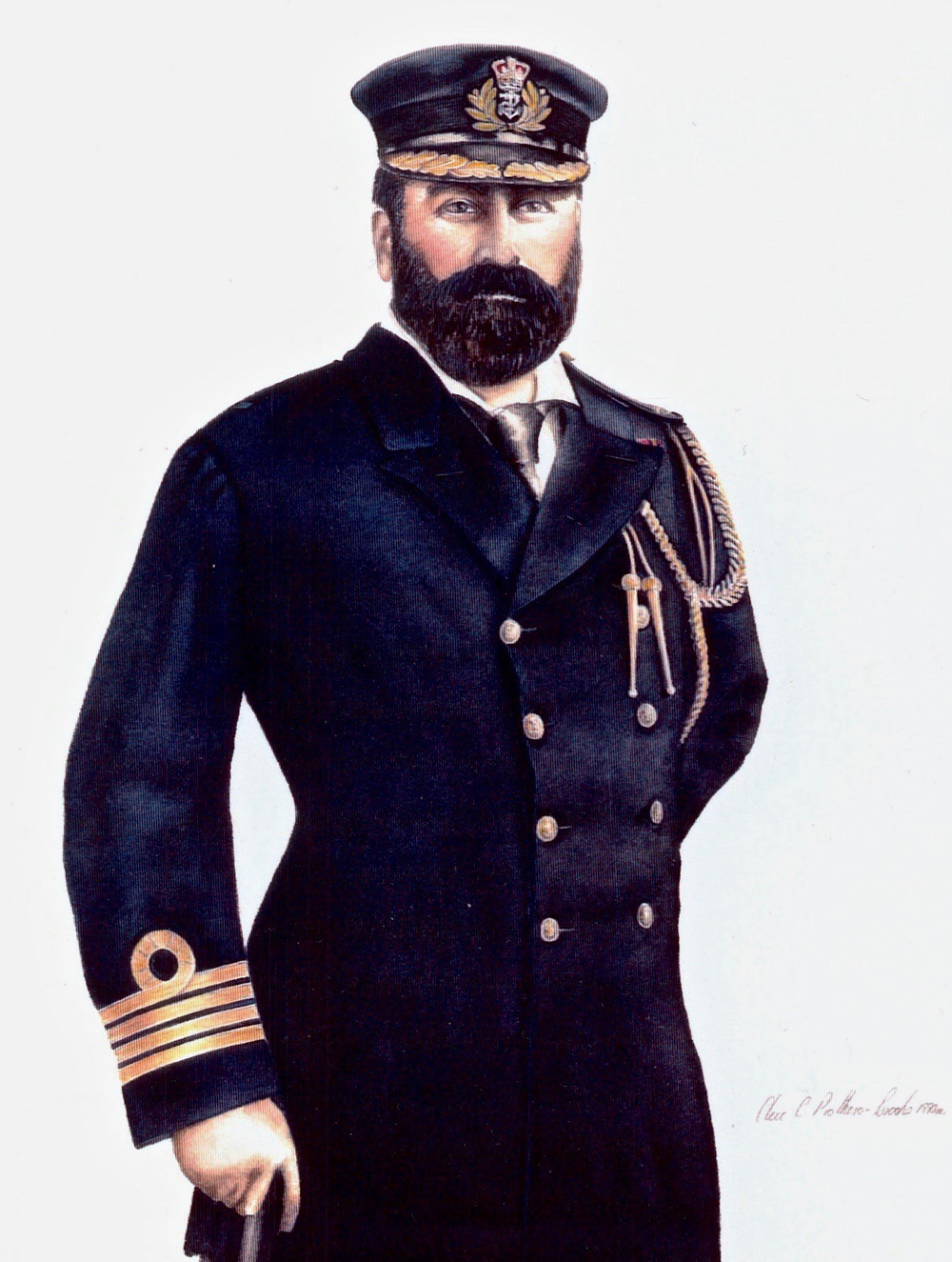
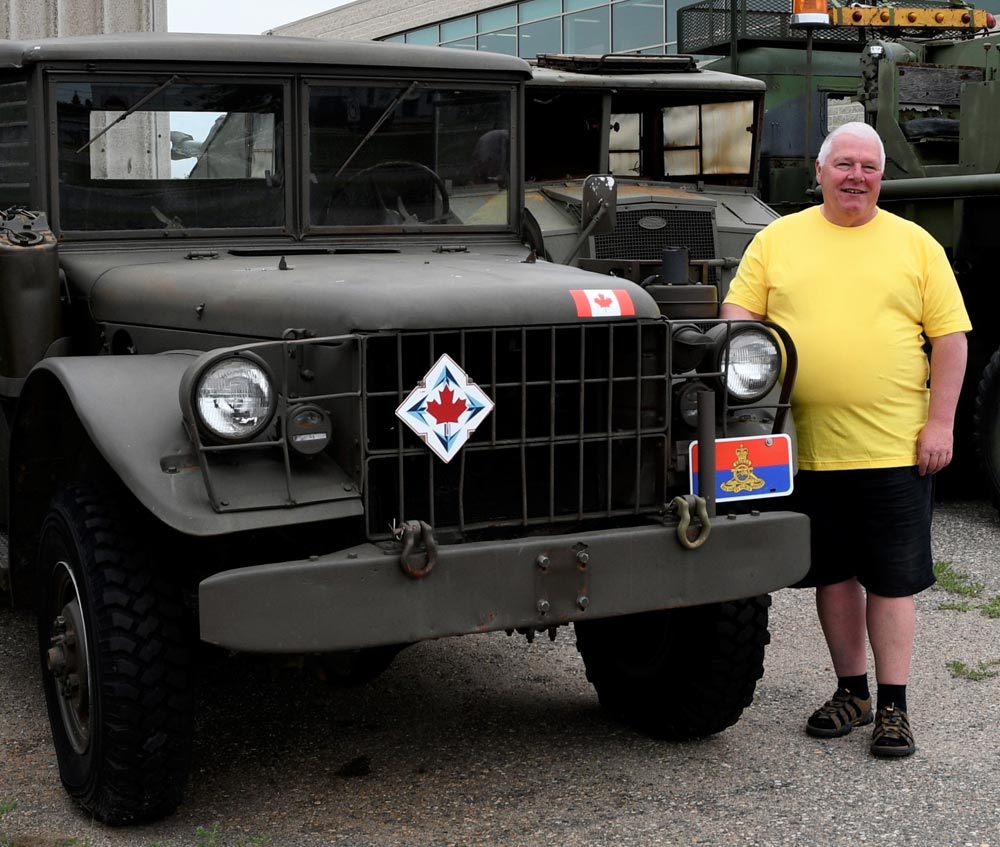
Jules Xavier
Shilo Stag
He’s often one of the first individuals on the Base wearing shorts and his colourful Crocs, and the last to put on pants once frigid temperatures arrive on the Manitoba prairies.
Working as the RCA Museum’s collection manager, Clive Prothero-Brooks is a fountain of information when it comes to military history. The 67-year-old rides quirky bikes he finds overseas, and has shipped to Brandon from the UK. Likewise, he finds rare cameras of varying sizes and eras, and has them shipped from places like Japan, to his Brandon home he shares with wife Patti and three cats.
Coming up on a significant milestone in his work life, Clive will call it a career at the RCA Museum when he departs his Base office Sept. 1. He’s retiring after 50 years service in the Canadian Armed Forces (CAF) and DND, including 23 years with the RCA Museum.
According to museum director Andrew Oaken, “Clive will leave an indelible mark on the museum, contributing his skills and expertise, influencing colleagues, and imparting an unequivocal legacy. His knowledge of military history has been invaluable to the museum, while his mentorship, positivity, and good nature have played a pivotal role in shaping many careers.”
Looking back on his life, in 1973, at age 17, Clive joined the Canadian Scottish (Princess Mary’s) Regiment in Victoria, British Columbia. He transferred to the Lincoln and Welland Regiment as a rifleman in St. Catharines, Ont., then moved back to the Canadian Scottish from 1974 to 1978. He also received a Fine Arts diploma from Camosun College in 1979.
“While I was going to school I was with the militia part-time and just stuck with it,” he recalled. “Mom suggested I go back to England and with a family tradition of going into Navy, I chose the Royal Marines and I picked the most difficult group to join, and I didn’t get in. So I returned home and stayed with the Canadian Scottish as a bass drummer from 1978 to 1990. He transferred to HMCS Malahat as a Boatswain in Esquimalt, BC, from 1990 to 1992.
Looking back on Clive’s family history and connection to the British Navy and Royal Canadian Navy (RCN), he can trace it to his mother and father meeting during the Second World War. His grandfather was also with the British Navy.
“Mom was a registered nurse on ship with the Royal Canadian Navy when she met dad, who transferred to the RCN as an officer in 1943,” he recalled. “Dad was busy in the war. He was at Anzio. His merchant ship was sunk at Dunkirk. On the MHCS Prince Henry, an armoured carrier, he was part of D-Day landing at Juno Beach.”
Meanwhile, as a sergeant, Clive was the drum major for the Canadian Scottish from 1992 to 1995. In 1995, he transferred to 1RCHA at CFB Shilo, Manitoba, with 1RCHA’s HQ and Svs Bty and as the drum major.
“Who knew you could transfer to artillery where I could use my fine art skills to paint drums on calf skin. I first tested the paint on wood, and it worked. Now I paint on mylar, not calf skin,” he said.
The rest is history when it comes to drum painting, as Clive does not advertise, but military clients find him in Manitoba.
“I guess I’m the only one really doing it in Canada — it’s a dying art,” he offered. “I also started doing Change of Command scrolls. Col Hodgson knew I was an artist so he asked me to use my painting skills.”
His work can be found across Canada, including the Royal BC Museum. With retirement in the offing, and his passion for art, he concedes he will likely continue to offer his artistic skills to those who reach out to him. Retirement does not equate to having lots of free time.
Especially when Clive is also a handy mechanic, who has worked on British cars in his youth, finding garage jobs when he was living in the UK.
“I know my British sports cars,” he said. “Right now I’m working on a 1968 TR4A [Triumph]. I also have two American cars, a Cadillac, and a station wagon which is a gas pig.”
Recalling his early days posted to CFB Shilo, Clive lived in the “shacks” for five years starting in 1995.
“I was here for the mystery tour,” he laughs. “I was supposed to go to Bosnia, but it fell through and I did not go.”
From 2000 to 2005, Clive was the curator at the RCA Museum. Since 2006, he’s been the museum’s collection manager.
“I’m not one for paperwork or meetings, so I like what I do at the museum looking after the collection. I’m on my own, with my music playing in the background,” he said.
Since 1980, Clive has been a freelance military artist specializing in military drum emblazoning and painted drums for units across Canada. He also has a vibrant collection of British cars and motorcycles, collecting dozens over the years, and is now down to six cars and two motorcycles. They are his pride — a 1952 Sunbeam with side car, and a 1949 Metro Police used in the UK.
Other hobbies include collecting toy soldiers, vintage Hi-Fi, and film, plus an array of bicycles and cameras. And more than 40 pairs of shoes, including his favourite colourful Crocs. Clive plans to continue his hobbies and pursue black and white photography and woodwork projects. This means finally building a darkroom at home. He also plans to restore a 1959 Rover P4 100 out of his 800 square foot garage.
“I think I have 30-plus cameras now,” he said. “And nine bikes. My favourite is my Pedersen which is hard to find, but I found one and had it shipped from England.”
The Pedersen bicycle, also called the Dursley Pedersen bicycle is a bicycle developed by Danish inventor Mikael Pedersen and produced in the English town of Dursley. Though never hugely popular, they enjoy a devoted following and are still produced today.
Their unusual frame is described as pure cross, was marketed as cantilever, and features a distinctive hammock-style saddle. Variations include lightweight racing, tandem, and folding designs. Other Pedersen innovations include two and three-speed internally geared rear hubs. Pedersen received a patent in the United Kingdom for his bicycle in the early 1890s and constructed the first model out of wood.
According to Oakden, “Clive’s retirement will leave a void at the museum. His retirement marks the end of an era and the culmination of decades of hard work, dedication, and commitment. He is a source of inspiration, a reservoir of knowledge, and a testament to positive values and good humour. We honour Clive’s 50 years of service and celebrate his journey into a well-deserved retirement.”
Clive also likes his working relationship with museum mechanic Rob Love.
“In my early days I did a lot of mechanical things with Rob,” he recalled. “I like working on uniform projects. This has been a rewarding job for sure … I can’t do it all, with this large collection, but I think I’ve made a difference. Now we have a data base to work from, rather than just sorting through many boxes.”
In 2018, Clive was recognized for his 45 years of exemplary service with the Canadian Armed Forces (CAF), when he received a 3CDSG Command Team commendation. It was presented to him at Base HQ by former 3CDSG Comd Col Scott McKenzie.
The citation reads: “As a collection manager, he has done an admirable job in maintaining a collection of more than 65,000 pieces. He is an expert on the history and heritage of the Royal Regiment of Canadian Artillery and is highly regarded amongst his peers. His dedication and passion for military history has played an integral role in the success of the RCA Museum.”
Yes, Clive is passionate and knowledge about his work. His expertise comes in useful when Oakden is doing research for his articles he shares with the Shilo Stag.
His work at the museum has not gone unnoticed by others, too. Like Doug Welykholowa.
“We were most fortunate to have him join the museum staff, with his expertise and can do attitude, particularly at a time when we were transitioning from the old museum to N118. He has left the collection in excellent shape and will be missed,” he said.
What will Clive miss after he turns in his keys to his office and museum?
“Mainly the people,” he offered. “I made a point of seeing people on Base in person. I know there are people here who have not been to the museum. I get that … but I’ve always got a long with people who I have met outside the museum, so if I can in anyway encourage them to visit, I do. There’s lots of history from this Base on display, plus the history of the Royal Canadian Artillery.”
He added, “I never felt like this was a job. Yes, I did not like the winter driving, but once I’m in my office, working in the collection, this is a lot of fun.”
For now, in retirement, Clive will call Brandon home.
“It’s not what I planned, as I would have liked to go back to Vancouver Island. But now, it’s a big expense relocating back to Victoria.”
Clive has a son, Eric, and two grandsons who live in Victoria, BC. He also has an older sister, Penelope, who calls Scotland home.
Clive Prothero-Brooks showed off his newest Pedersen bicycle during the annual Terry Fox Run. When he acquires a new camera, he will bring to the Stag’s office to show the editor. Clive shared a photograph taken on the Bonneville Salt flats circa 1988 with his 1968 Rover 2000TC. 1RCHA CO LCol Joe O’Donnell arranged for Clive to fire a last round with the M777 during his unit’s family day weekend. Clive had an opportunity to chat with 100-year-old Second World War artillery veteran Pte Tufts during his visit to the museum in 2022. Clive wore a sailor’s suit alongside his father Lt Cdr Charles Brook taken in 1963. The portrait on the wall is his great-grandfather, which he painted a portrait of years later after he earned his Fine Arts diploma. Some of the drums Clive has painted since he combined his early military career with his interest in art. Photos Jules Xavier/Shilo Stag


